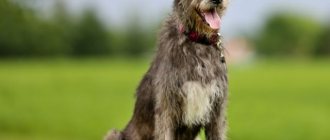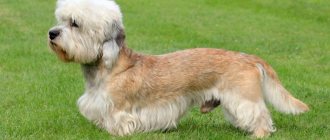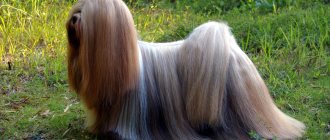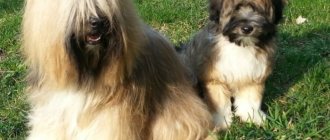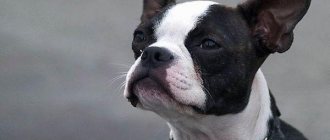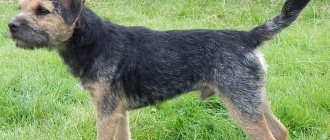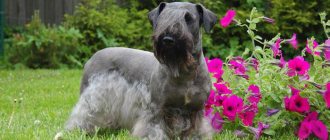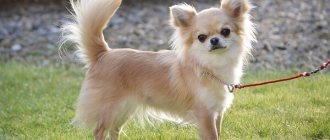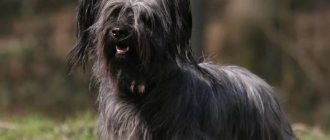History of the origin of the breed
The Bedlington breed was developed in the 18th century in England. Surprisingly, the documents even preserve information about one of the first representatives of the breed - the dog Old Flint, who lived at the end of the century in the small town of Rothbury. At that time, England was literally at war with small rodents and dogs served as rat hunters. They became especially popular in the mining town of Bedlington, from which they got their name.
Soon these terriers began to be taken on real hunts for rabbits, foxes, and other small animals. In addition to hunting, terriers were used for baiting, which is why they became more aggressive.
Later, dog breeders realized that Bedlingtons needed serious work on their temperament and conformation. By eliminating unnecessary aggression and making the appearance of terriers more vibrant, dog lovers finally got their own club and set a breed standard.
History of the Bedlington Terrier
Bedlington is the name of a mining town located in the north of England. Dogs were used in mines to exterminate rodents . As entertainment, terriers were pitted against each other in dog fights .
Whippet, bull terrier, poodle and others were used in breeding this breed.
As a breed, the Bedlington Terrier was established by 1825 . The first unofficial standard was drawn up by James Scott only in 1875 , and the breed received a name and description.
This dog has become popular among gypsies due to its funny appearance and ability to train. The dogs were taught to deftly and quietly steal the wallets of passers-by.
It is known that Bedlingtons were kept by English peasants for hunting. Forest law imposed a ban on hunting in the royal forests. To feed his family, a person had to secretly track the beast . A small terrier that does not bark when hunting was a perfect fit. The decorative appearance averted suspicion of hunting abilities.
Today it is a companion dog. He is a fast runner, which helps him compete in greyhound racing and agility . Some owners use the Bedlington to hunt small animals.
Description of the breed
The dog's build resembles that of a hound. The head is narrow, shaped like a pear, the muzzle goes down slightly. The neck is high and muscular. The chest is deep, with somewhat prominent, noticeable ribs. The hind legs are longer than the front legs. The terrier's tail resembles a saber. The eyes are deep-set, triangular in shape and brown in color. The nose is wide, and the lips are dry and pressed tightly to the jaw. The nose and lips of terriers are always black.
Weight and height
Bedlington Terriers are a small breed, the height at the withers reaches 38-42 cm in females and 41-44 cm in males, with a weight of 11 kg, which allows them to be kept in an apartment.
Color and coat
The Bedlington's coat is soft and silky, with a little curl. Its color can be very diverse: from snow-white to red-brown. But more often there are representatives whose coat is light in color. At the same time, the coat on the head of dogs is always longer and lighter than on the entire body.
Bedlington Terrier pregnancy and birth
From the day of the first mating to the birth itself, 56 to 72 days . It is advisable to note the day of mating in order to know how long the dogs are pregnant. Too early and too late births most often lead to the death of the litter, so in both of the above cases it is necessary to seek help from a qualified veterinarian. The gestation period in dogs may be shortened due to the small number of offspring.
Typically, young females produce fewer puppies.
The litter size increases when the dog reaches 3-4 years of age, then decreases again. The duration of pregnancy in dogs is not very long; it is not so easy to determine that a dog is pregnant.
Obvious signs of pregnancy in dogs appear at quite late stages. Neither palpation nor the appearance of the pet at an early stage of pregnancy will tell the owner whether the mated bitch is expecting offspring or not. The first signs concern not so much the external appearance as the mental state, and therefore the behavior of the pregnant bitch. The dog, as a rule, becomes calmer, shows affection more often and demands affection from others. Sometimes the animal may not even seem completely healthy.
If the pregnancy is progressing normally, the specialist can establish pregnancy by palpation in the third week. After a month, the dog’s belly noticeably enlarges, and in the fifth week the mammary glands swell and lighten. Shortly before giving birth, the bitch's belly drops. A characteristic sign of approaching labor is abundant discharge from the loop, yellowish or greenish in color.
Also prepare a “maternity kit” so that everything you need is at hand, it should include:
- old duvet covers or large disposable diapers (60*90), on which the bitch will whelp (disposable diapers are preferable - less washing and more cleanliness);
- a lot of small soft rags ironed with a hot iron from old bedding (to dry puppies);
- sterile gauze wipes (usually unnecessary, the puppy’s mouth is dried with a piece of cloth, into which, in fact, the puppy is received);
- a pen, a notebook, scales and thick woolen threads or ribbons (it is better to use floss, because the bitch simply licks and removes woolen threads);
- afterbirth bowl;
- a box or basin for puppies with a heating pad (wrapped in a diaper) - this is in case the bitch behaves restlessly during childbirth and there is a risk of losing the puppies... the best option is a bitch giving birth with puppies at the nipples;
- sterile scissors and a medical clamp (it is not necessary to boil; at the onset of labor, place in a jar with any alcohol);
- milk chocolate bar;
- an antiseptic, preferably a spray (Aluminium, Xidicol, Septonex) for treating the umbilical cord.
And also a puppy resuscitation kit:
- cordiamine to stimulate cardiac activity (a drop on the tongue of a newborn);
- an oxygen canister (to give a weak puppy a chance to breathe), costs about 400 rubles in pharmacies;
- small rubber heating pad;
- a small enema for suctioning mucus from the mouth of a very weak puppy.
As for medications, during a normal birth they will not be needed, and if you had to resort to the help of a veterinarian, then he will have the necessary kit. Just in case, you can keep in stock No-shpu in ampoules, glucose 5% solution for infusion; calcium gluconate (a box, may be useful after childbirth).
You will also need a watch to mark the time of birth of the puppies and a notepad to record the details of the whelping (they will come in handy in the future), with your veterinarian's phone number displayed in a visible place. It's also great to have a scale for weighing newborn puppies. The puppy's birth weight, among other whelping details, should also be recorded in a notebook.
Bitches usually whelp between 58 and 63 days. Large litters are born earlier, and small ones a little later.
In the last days before whelping, you need to monitor the bitch’s body temperature. The normal temperature measured in the anus is about 38.5°C. Two days before giving birth, the bitch's temperature usually drops to 37°C or even lower. But since this does not always happen, you need to be attentive to all other signs of impending whelping. And yet, more often than not, if the temperature remains normal, then the bitch is unlikely to whelp in the next 24 hours.
Before whelping, it is good to give the bitch a mild laxative to help her cleanse her intestines.
It is better if, 2-3 days before the expected birth, you call a veterinarian or clinic, warning in advance about a possible call; in any case, the necessary phone numbers should be in a visible place.
Character and behavioral characteristics
Bedlington Terriers can be quite stubborn and strive to match their humans. But at the same time, they are smart enough to train and socialize them. To cope with the dog’s temperament, the owner has to constantly train the dog, not only physically, but also intellectually. The history of the development of this type of terrier has preserved their fighting qualities, therefore, on the orders of the owner, the dog can show harshness and even cruelty towards other animals or people.
Their willful and freedom-loving temperament brings a lot of trouble to their owners, so it is not recommended to own such dogs if you have insufficient experience working with dogs. Naturally, there can be no talk of any friendship with children in this situation. In general, Bedlingtons, like other terriers, are active, fearless and loving. They can protect their family and home, although with proper training they will not go beyond loud barking.
Description of the nature of the breed
If you want to see what a lion in sheep's clothing looks like, look no further than Bedlington Terriers. They look like a sheep, but are actually not so harmless. Behind the cute curls hides a real self-sufficient lion's temperament.
If you do not educate them from infancy, they often become irritable and aggressive. But, despite this, they will not be the first to start a mess, although they will gladly take part in it. They treat other animals that live in their neighborhood quite peacefully and calmly.
Since the name of the breed contains the prefix “terrier,” Bedlingtons are stubborn and capricious. They try to do everything their own way. At the same time, they perfectly coexist with such qualities as obedience and the desire to please the owner, but only if they see their interest in this.
They develop very trusting relationships with their owners, and they can be devoted and faithful friends and companions. These dogs are affectionate towards children and enjoy playing with them.
Bedlingtons are truly sophisticated aristocrats. Even during mischievous games, they behave quietly and will not turn the whole house upside down. They are also big clean people who will never allow themselves to walk through mud or puddles.
Education and training
Bedlington Terriers are highly trainable. With the right approach, an experienced owner can raise an obedient, non-aggressive pet. The stubbornness and willfulness of the animal requires the owner to create such conditions during training when the dog enjoys following commands, so it is better to choose play tactics. But at the same time, from a very early age, the dog must know its place and be able to see the boundaries of what is permitted. Even cute pranks should not get away with your pet. The owner must be even more willful and stubborn than the terrier, and his dominance in the relationship will have to be proven.
The owner of such a dog must remember the hunting skills of his shaggy friend and allow him to use his instincts. It is useful to perform exercises similar to hunting during training. It is absolutely necessary to attend agility classes for those dogs that you really plan to take hunting in the future.
Diseases
The breed is prone to several serious diseases:
- copper toxicosis;
- distichiasis;
- retinal dysplasia.
All of them are related to the characteristics of the dog. Toxicosis occurs when a large amount of copper accumulates in the animal's body. In this case, the liver suffers the most. Disease can only be avoided if the dog’s diet is strictly controlled.
Distichiasis and dysplasia occur due to the special structure of the animal’s eyes. The owner should regularly take care of eye hygiene and, if symptoms of disease appear, immediately contact a specialist. A healthy Bedlington can live 12-14 years.
Hunting
Today, Bedlington rarely participates in real hunting for foxes, badgers, rabbits and other animals living in burrows. But owners often organize a hunting game for their pets, called agility. At their core, such games are real sports and dogs fully realize their hunting skills during training.
In principle, a dog that has undergone agility training may well participate in a real hunt. This will even be useful for the dog, as it will allow him to actively spend time and spend all his accumulated energy. But at the same time, during simple walks, the Bedlington will have to be kept exclusively on a leash, since it can perceive any small animal as an object of hunting.
Dog care
The main concern for the Bedlington Terrier concerns the animal's delicate fur. Here you need to follow a few basic rules:
- Brush the coat regularly with a brush and slicker.
- Provide haircuts at least 3-4 times a year.
- Wash as needed, as these dogs are very clean and rarely get dirty outside.
In addition to caring for the fur, the owner must clean the animal’s ears, eyes and teeth. This will avoid a large number of infectious diseases. There are no other difficulties regarding content.
Dog nicknames: names for Bedlington Terriers
Most people prefer to choose a short, sonorous name for their dog.
You will have to say your dog's name many times a day, and if it is too long, it will be tiring.
When choosing what to name your Bedlington Terrier, you can follow two methods.
- The first and easiest: open the list of the most suitable names for this breed and choose the one that you like best .
- Second: choose an unusual name from other sources, for example, from mythology or literature, name the dog after your favorite celebrity , or come up with your own exclusive name .
There are many suitable names for Bedlington Terriers girls:
- Iris,
- Bella,
- Assol,
- Greta
The following names are good for a boy's Bedlington Terrier:
- Jay,
- John,
- Terry,
- Gray.
Feeding
Due to a genetic predisposition to accumulate copper in the liver and throughout the body, Bedlington Terriers require a special approach to nutrition. Unlike most other species, feeding this breed with dry professional food is not recommended. In some cases, this type of food is allowed, but on the condition that the food has premium or super-premium status.
If the choice still stops at natural products, then the diet should contain:
- beef;
- chicken;
- a large number of by-products;
- sea fish (no more than 2-3 times a week);
- rice;
- millet;
- buckwheat;
- red vegetables;
- dairy products.
Potatoes, sausages, and all sweets should be completely excluded from the animal’s diet, and the diet of an adult dog is reduced to two feedings per day. Snacks are not allowed. To make sure that your diet does not harm your liver, you must undergo regular tests and consult with a specialist.
Care and maintenance
The coat of Edlington Terriers is demanding to care for . The dog is predisposed to certain diseases. It is advisable to keep your pet in an apartment, because... his fur will not allow him to live on the street. Nails are trimmed 1-2 times a month . Brush your teeth and check your ears and eyes weekly.
Nutrition
The breed does not have digestive problems, so terriers can be fed with any complete food, both ready-made professional and natural food.
- Natural food should be represented in the diet by lean meat (beef, lamb), you can partially replace it with offal, the menu should also include grains in the form of porridges, vegetables, eggs, fermented milk products, broths, sea fish (only boiled and without bones).
- Ready-made food can be dry or wet , but it is necessary to use premium or super-premium food. The brand is selected based on the tastes of the Bedlington, as well as the condition of the coat and the activity of the animal.
- A puppy aged 2 months should be fed 5-6 times a day , gradually reducing the number of meals by 10 months. The dog is fed like an adult dog, twice a day .
We recommend that you read a detailed article on the topic: “How and what to feed a dog: types and characteristics of nutrition.”
Health
The breed is relatively healthy. They live about 15 years , but are predisposed to some congenital diseases, which will be described below.
Vaccinations
Vaccination of Edlington Terriers is no different from the procedure for most breeds. Vaccination reduces the risk of your dog contracting the following diseases:
- coronavirus;
- rabies;
- hepatitis;
- parainfluenza;
- plague;
- leptospirosis.
- trichophytosis;
- parovirus enteritis;
Before administering the drug, it is necessary to assess the condition of the animal - a dog with signs of illness, lethargic, apathetic cannot be vaccinated. The grafting intervals are as follows:
- 7-8 weeks – vaccination with a product labeled DHPPiL;
- 12 weeks – vaccination with a product labeled DHPPiL + R;
7 days before the procedure, regardless of the pet’s age, the Bedlington must be treated for helminths.
After each vaccination, puppies are quarantined for 2 weeks , during which time the baby is not allowed to go outside. His condition should be closely monitored; if the temperature rises or appears unwell, you should contact a veterinarian. Adult terriers are vaccinated once a year; quarantine is not necessary .
Important article on the topic: “Everything you need to know about dog vaccinations.”
Diseases
The breed is predisposed to certain diseases. Common health problems include:
- Copper toxicosis . A hereditary disease, an animal can be sick, or be only a carrier and pass the problem on to its offspring. With this toxicosis, copper accumulates in the kidneys, which is not excreted from the body. A sick dog needs lifelong therapy and diet; if left untreated, tissue necrosis occurs and the animal dies. Testing for the presence of the disease is carried out.
- Renal hypoplasia . It suggests a congenital anomaly of the structure of one or both organs. The kidney is reduced in size, hard, and poorly copes with its functions. If there is damage on one side, the animal is able to live; with supportive treatment, the second organ enlarges and takes on the load. If both kidneys are diseased, the puppy usually dies in infancy.
- Retinal dysplasia . This is a violation of layer formation during embryonic development. The first manifestations are clouding of the surface of the eye, discharge from it, and impaired coordination of movements. In severe cases it leads to blindness. Tests for the presence of the disease are carried out at 7-12 weeks .
- Patella dislocation . Involves displacement of the joint inward or outward relative to its normal position. The first manifestations occur when running or playing, when the animal falls on one paw, whines and limps, and after a while returns to normal behavior. There are several stages of the disease; in the first, the cup falls into place on its own; in the last, it cannot be adjusted. Determined by ultrasound and x-ray diagnostics.
Walk
The Bedlington Terrier is a moderately active dog . She will be happy to take part in a country hike, but she will be no less happy to lie on the sofa with her owner.
You need to walk it 2-3 times a day, at least once a week you need to give the animal the opportunity to play on the dog park or run around in nature.
In winter, it is better to dress your pet in overalls so that he does not freeze while walking . On the street, at least once a day, it is advisable to take an active walk: throw a ball, stick or frisbee to the dog. Any games that involve intellectual activity are suitable - searching for an object, a person, going through dog mazes.
The Bedlington will also be interested in running behind a bicycle or roller skates, agility, freestyle, and, as a hunter, coursing. It is important to keep an eye on your pet so that the stalker instinct does not lead it far from its owner.
Grooming
The Edlington Terrier has a thick coat, but does not shed much hair during shedding. It can also be noted that the dog does not have the characteristic dog smell.
- It is advisable to groom your pet's fur weekly with a comb; during shedding , you can use a slicker or furminator, within reasonable limits.
- bathe your pet as rarely as possible so as not to disturb the hair structure. This must be done before grooming.
- at least 3-4 times a year , leaving a length of about 2-3 cm . The tassels on the ears and the cap on the head are not removed, they are only given shape. Most of the breed's haircuts are difficult to do on your own . Using a machine, hair is removed from both surfaces of the ears, on the lower jaw, throat, belly, inner thighs, and tail (except for the base).
- Scissors are also used, cutting with the tips to prevent the appearance of “ladders”. They remove hair in the ear canal, trim the cover on the sides of the muzzle, on the neck, limbs, paws, and shape the cap. The hair on the sides is made shorter than on the back, on the body less than on the chest, on the legs longer than on the body, the haircut of the paws should emphasize their “hare” shape.
How to choose a puppy
Typically, Bedlington Terrier puppies are purchased at about two months of age. In this case, it is necessary to evaluate the behavior and appearance of the animal. A healthy puppy is active, cheerful and extremely sociable, with shiny coat and clean, clear eyes.
It would be good if, before selling, the animal was accustomed to combing, washing, and other grooming procedures. This will allow the new owner to quickly find a common language with the animal, avoiding unnecessary aggressiveness and dissatisfaction on his part.
Choosing a Bedlington Terrier puppy
- If you want to have a healthy dog, do not buy a puppy from your own hands. Find a reputable Bedlington Terrier kennel where the dogs are professionally bred and can be ensured that they are free from genetic diseases.
- A healthy puppy is sociable, active, has an appetite, is inquisitive and playful, and is ready to approach people.
- It is worth looking at at least one of the parents to see their temperament.
- Examination of siblings and in-laws is also helpful in assessing what the puppy will be like when it grows up.
Price and where to buy a puppy
It is best to buy a dog from a professional breeder or kennel. In this case, you can be sure that the baby’s pedigree contains only purebred ancestors, and the puppy himself will be given all the relevant documents. A puppy bought secondhand may be too aggressive, since neither he nor his parents most likely received professional education and training. The cost of a terrier varies from 45 to 70 thousand rubles.
Briefly about the main thing:
- Bedlingtons were bred in England primarily to kill mice.
- The breed has excellent fighting, guard and hunting qualities.
- The build is similar to a hound, but the soft curly hair and unusual head shape make the dogs similar to sheep.
- Puppies learn well if training is structured in the form of exciting games.
- They require a special approach to feeding due to their tendency to copper toxicosis.
- It is better to buy a puppy from a nursery starting from 45,000 rubles.
